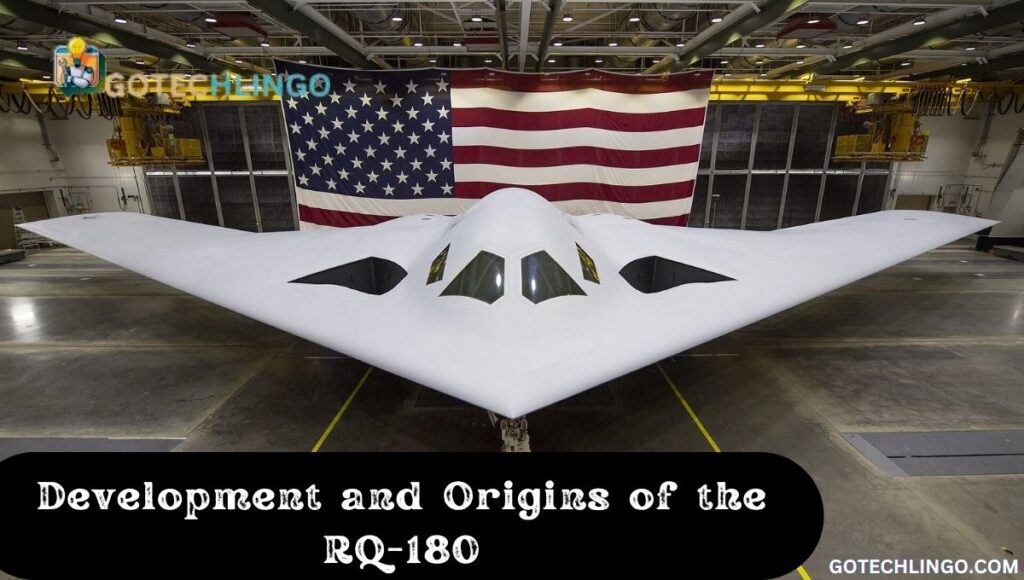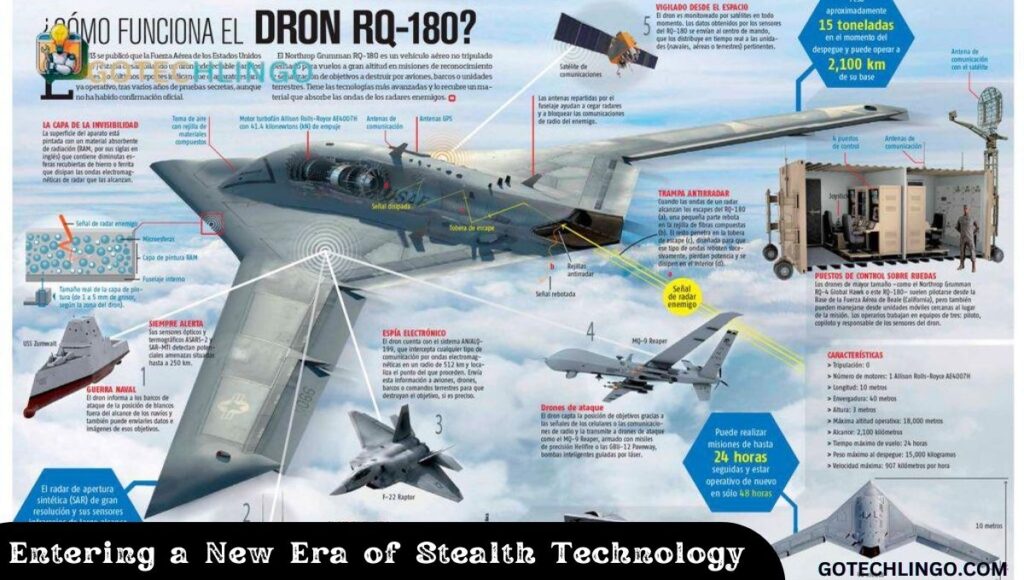In the cloak-and-dagger world of military aviation, few aircraft capture the imagination quite like the RQ-180 – a highly classified, stealthy unmanned aerial vehicle (UAV) operated by the United States Air Force.
Shrouded in secrecy, this cutting-edge reconnaissance drone represents the next generation of intelligence, surveillance, and reconnaissance (ISR) capabilities for the U.S. Armed Forces.
The mere existence of the RQ-180 has piqued the interest of defense experts and tech enthusiasts alike, as its advanced stealth features and extended range promise to revolutionize how aerial reconnaissance is conducted in the modern battlefield.
While details about its precise capabilities remain closely guarded, the RQ-180 is widely regarded as a technological marvel – a testament to America’s relentless pursuit of tactical superiority in the skies.
Development and Origins of the RQ-180

The origins of the RQ-180 can be traced back to aerospace giant Northrop Grumman, the company responsible for developing this clandestine UAV.
As the U.S. Air Force sought to replace its aging fleet of reconnaissance aircraft, including the venerable U-2 Dragon Lady and the RQ-4 Global Hawk, the need for a new, stealthy platform capable of operating in contested airspace became increasingly apparent.
Northrop Grumman, already a leader in the field of unmanned systems, was tapped to spearhead the development of this next-generation ISR drone. Drawing upon its expertise in stealth technology, the company set out to create an aircraft that could evade enemy air defenses and provide the U.S. military with unparalleled intelligence-gathering capabilities.
Early hints about the RQ-180’s existence began to surface in the late 2000s, as the U.S. Air Force Chief of Staff at the time, General Norton Schwartz, made cryptic references to a “new intelligence, surveillance, and reconnaissance aircraft” that was in development.
This sparked a wave of speculation and anticipation within the defense community, as the prospect of a stealthy, high-altitude reconnaissance drone capable of penetrating deep into enemy territory captured the imagination of military aviation enthusiasts.
Entering a New Era of Stealth Technology

What sets the RQ-180 apart from other UAVs is its advanced stealth features, which are designed to make the aircraft virtually invisible to radar and other detection systems. By leveraging cutting-edge materials, aerodynamic designs, and radar-absorbing coatings, the RQ-180 is believed to have a significantly reduced radar cross-section compared to other reconnaissance drones, such as the RQ-4 Global Hawk.
This focus on stealth technology is a testament to the RQ-180’s role in ushering in a new era of unmanned aerial surveillance. Unlike the RQ-4, which is relatively large and easy to detect, the RQ-180 is designed to operate in highly contested airspace, providing the U.S. military with critical intelligence without risking the loss of a manned aircraft.
In many ways, the RQ-180’s stealth capabilities are reminiscent of other famous American stealth aircraft, such as the B-2 Spirit bomber and the F-22 Raptor fighter jet.
These aircraft, which have set new standards for low-observable technology, have paved the way for the development of the RQ-180, pushing the boundaries of what is possible in the realm of stealthy, high-altitude reconnaissance.
Advanced Features and Design of the RQ-180
One of the RQ-180’s most impressive features is its high-altitude capabilities, which allow it to operate at extreme elevations that are well beyond the reach of most conventional air defense systems. Estimates suggest that the drone can reach altitudes exceeding 60,000 feet, putting it on par with the legendary U-2 spy plane and the RQ-4 Global Hawk.
This altitude advantage, combined with its advanced stealth features, enables the RQ-180 to conduct ISR missions deep within enemy territory without being detected. The drone’s extended range and endurance, which is believed to exceed 24 hours of continuous flight, further enhance its ability to gather critical intelligence over vast areas of interest.
Additionally, the RQ-180 is rumored to incorporate a high degree of autonomous technology, allowing it to navigate complex airspace, detect and avoid threats, and transmit real-time data back to its operators with minimal human intervention.
This level of autonomy is a significant leap forward in the field of unmanned aerial systems, and it promises to revolutionize how the U.S. military conducts ISR operations in the future.
RQ Decoded: Unpacking “Real Quick” in Conversations
Revolutionizing Intelligence Gathering
The RQ-180’s advanced surveillance capabilities have the potential to significantly enhance U.S. national security efforts.
By providing unparalleled access to denied or contested airspace, the drone can gather critical intelligence on adversary movements, weapons systems, and other sensitive military activities that were previously out of reach for traditional reconnaissance assets.
This intelligence can then be used to inform strategic decision-making, improve the situational awareness of commanders, and support a wide range of military operations, from precision strikes to counterterrorism efforts.
The RQ-180’s ability to transmit real-time data back to its operators also allows for the immediate exploitation of intelligence, ensuring that the U.S. military can respond quickly and effectively to evolving threats.
Moreover, the RQ-180’s advanced sensors and data-processing capabilities can be leveraged for a variety of intelligence-gathering tasks, including signals intelligence (SIGINT), electronic intelligence (ELINT), and even imagery intelligence (IMINT). This versatility further enhances the drone’s value as a critical asset in the U.S. military’s intelligence, surveillance, and reconnaissance arsenal.
Secret Missions and Sightings
Despite its highly classified nature, the RQ-180 has managed to capture the public’s imagination through a series of reported sightings and media coverage.
One of the most notable incidents occurred in 2013, when the U.S. government quietly acknowledged the existence of the drone, marking the first official confirmation of its development.
Since then, there have been numerous reports of unusual aircraft sightings over classified locations, such as the infamous Area 51 in Nevada, that have fueled speculation about the RQ-180’s ongoing missions and deployment.
While the U.S. Air Force has remained tight-lipped about the drone’s activities, these sightings, coupled with satellite imagery analysis, have provided tantalizing clues about the RQ-180’s capabilities and potential involvement in clandestine operations.
The secrecy surrounding the RQ-180 has only served to heighten public interest and fuel the ongoing debate about the role of unmanned aerial systems in modern warfare.
As the drone’s existence and development remain classified, the true extent of its capabilities and impact on U.S. intelligence-gathering efforts may not be fully known for years to come.
Looking Ahead: The Future of the RQ-180 and Stealth Drones
As the U.S. military continues to invest heavily in the development of advanced unmanned aerial systems, the RQ-180 is widely expected to play a pivotal role in shaping the future of aerial reconnaissance and surveillance.
With its unparalleled stealth features, high-altitude capabilities, and autonomous technology, the drone is poised to redefine how the U.S. gathers and acts upon critical intelligence in the years ahead.
The lessons learned from the RQ-180’s development are likely to have far-reaching implications for the next generation of stealth drones, both in military and non-military applications.
As other nations strive to keep pace with the U.S. in the realm of unmanned aerial technology, the RQ-180’s groundbreaking design and capabilities will undoubtedly serve as a benchmark for future advancements in the field of stealth aviation.
Moreover, the RQ-180’s success may also contribute to the gradual retirement of manned reconnaissance aircraft, such as the venerable U-2 “Dragon Lady,” as the U.S. Air Force increasingly relies on advanced, stealthy UAVs to conduct high-risk ISR missions.
This shift towards unmanned systems promises to enhance the safety and effectiveness of aerial intelligence-gathering, while also reducing the potential for human casualties in hostile environments.
As the veil of secrecy surrounding the RQ-180 slowly lifts, the true impact of this enigmatic drone on the future of warfare and global security will become increasingly apparent.
One thing is certain: the RQ-180 represents a significant leap forward in the realm of stealth technology, and its legacy will undoubtedly shape the way the U.S. military conducts intelligence, surveillance, and reconnaissance operations for decades to come.
Frequently Asked Question
Does the RQ-180 exist?
Yes, the RQ-180 is a real and operational unmanned aerial vehicle (UAV) developed by Northrop Grumman for the United States Air Force. Its existence has been officially acknowledged, though many details about the drone remain highly classified.
What is the difference between the RQ-180 and B-21?
The RQ-180 is a classified, high-altitude reconnaissance drone, while the B-21 Raider is a new stealth bomber aircraft being developed by Northrop Grumman for the U.S. Air Force.
How much does the RQ-180 drone cost?
The exact cost of the RQ-180 drone is not publicly known, as it is a classified program. However, estimates suggest the RQ-180 likely costs several hundred million dollars to develop and produce, given its advanced stealth features and technology.
How fast is the RQ-180?
The top speed of the RQ-180 is not officially disclosed, but it is believed to be capable of high-subsonic speeds, likely in the range of 500-600 mph.
What is the fastest aircraft in the world?
The Lockheed SR-71 Blackbird, a retired American strategic reconnaissance aircraft, held the record for the fastest operational manned aircraft, with a top speed of over 2,100 mph (Mach 3.3).
Final Thought
As the U.S. continues to invest heavily in the development of advanced unmanned systems, the legacy of the RQ-180 will undoubtedly shape the future of aerial reconnaissance and surveillance. The lessons learned from this highly classified drone will likely be applied to the next generation of stealth-equipped UAVs, further solidifying America’s technological edge in the skies.
Moreover, the RQ-180’s success may also contribute to the gradual retirement of manned reconnaissance aircraft, as the U.S. Air Force increasingly relies on autonomous, low-observable systems to conduct high-risk missions. This shift towards unmanned intelligence-gathering will not only enhance the safety of personnel but also improve the overall effectiveness and efficiency of aerial surveillance operations.
As the RQ-180’s true capabilities and impact gradually come to light, it is clear that this enigmatic drone represents a significant milestone in the evolution of modern warfare. By pushing the boundaries of stealth technology and revolutionizing the way the U.S. military gathers and utilizes critical intelligence, the RQ-180 has cemented its place as a transformative asset in the ever-changing landscape of global security.



